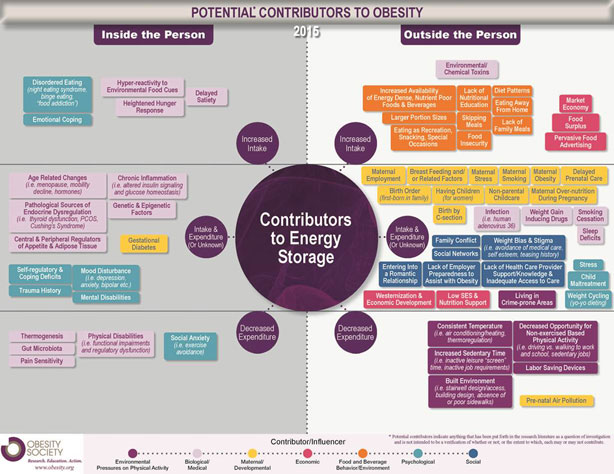TOS infographic outlines potential causes, contributors for weight gain
LOS ANGELES — A new infographic prepared by The Obesity Society will provide a streamlined list of the latest research on the potential causes and contributors of obesity, according to Nikhil Dhurandhar, PhD, FTOS, president of The Obesity Society.
Dhurandhar said in an interview that the task force that designed the infographic aimed to capture complex concepts pictorially and turn them into an easily accessible slide that can be disseminated freely to TOS members and the public.

Nikhil Dhurandhar
The graphic includes a list of potential contributors to obesity that were selected based on whether they have ever been a topic of investigation in the research literature. The task force divided the studies into two groups: “inside the person” (endogenous causes) and “outside the person” (exogenous causes). It then further broke down the studies into the categories of increased intake, decreased expenditure, or intake and expenditure together. Topics include “disordered eating” (increased intake, inside the person), “thermogenesis” (decreased expenditure, inside the person), “environmental toxins” (increased intake, outside the person) or “increased sedentary time” (decreased expenditure, outside the person), and are also color-coded by topic.

Source:The Obesity Society
“Because [obesity is] so complex, by dividing these [topics] and color-coding them ... I think this has come out excellent,” he said. “The amount of data that is conveyed in this one slide is a lot.”
Dhurandhar noted that the infographic will be updated with the latest research as it becomes available, creating a fluid, comprehensive listing of obesity-related studies.
“This is version 1.0, think of it that way,” Dhurandhar said. “As science advances, as we get input from members, this may change.
“This is version 1.0, think of it that way,” Dhurandhar said. “As science advances, as we get input from members, this may change.
“What it is supposed to do is point out the complexity of obesity,” he said. “When you put this slide up, you see it’s not just about eating more or moving less.
“There are numerous contributors that may be upstream of those two factors. We do believe energy storage is at the center ... but there are [other] factors that may ultimately lead to energy storage,” Dhurandhar said.
What the infographic is not meant to do, he said, is start a fight.
“This is not our attempt to say one [study] is worth more than the other,” Dhurandhar said. “This is not relative. We’re not knocking [a study] down, we’re not promoting it. It is what’s out there.” – by Regina Schaffer
Reference:
Dhurandhar N. TOS opening session. Presented at: ObesityWeek; Nov. 2-6, 2015; Los Angeles.
Disclosure: Dhurandhar reports no relevant financial disclosures.

